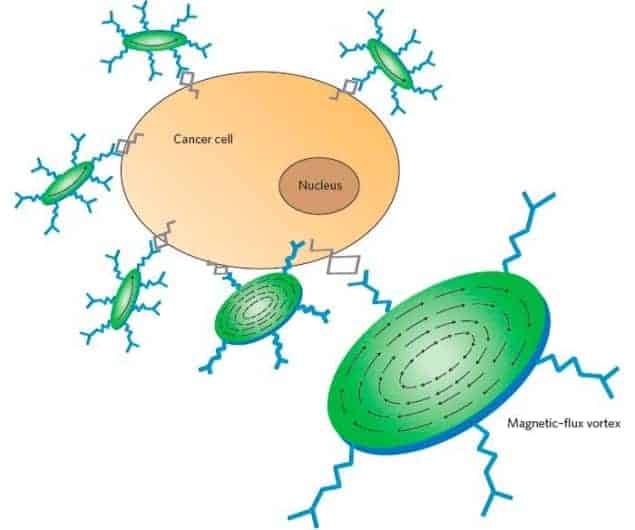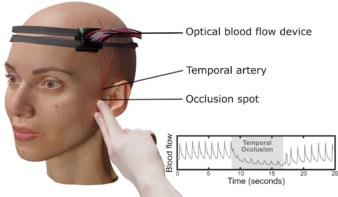
Researchers in the US are developing a new way of destroying cancer tumours that involves attacking them with tiny magnetic discs. Although the research is still a long way from finding medical application, it joins a growing number of innovations that are seeking to apply fundamental physics to the treatment of cancer.
The idea that magnetic particles could be used to target cancer tumours has been in the research community for several decades. The general principle is that drugs intended to destroy targeted cells could be attached to magnetic particles and guided to the appropriate places in the human body using external magnetic fields. Given the precision promised by this approach, it could offer obvious advantages over the crude targeting of chemotherapy, which can leave patients feeling extremely unwell.
Despite their early promise, however, these therapies have yet to yield much success in the field of oncology, mainly due to a number of technical issues. First, most experimental work to date has used superparamagnetic particles, which can only be controlled with strong magnetic fields that are not available in clinical settings. If the particles are made larger to compensate, they have a remnant magnetization even in the absence of external magnetic fields, and this can cause them to aggregate in clusters. Inside the body this process would be dangerous because it could lead to an embolism.
A new spin
In this latest research an interdisciplinary team from the Argonne National Laboratory and the University of Chicago offer a new spin on this technology that could help to overcome some of these technical problems. Instead of viewing the magnetic nanoparticles as a means of transport for drugs, the materials science researchers have designed a technique in which the particles themselves attack the cancerous cells by exerting a mechanical force.
“This treatment is not being designed to replace surgery, but it could accompany an operation for a number of types of brain cancer,” Elena Rozhkova, Argonne National Laboratory
Using a gold-shelled iron-based alloy that they developed, the researchers have created tiny circular discs that are just 60 nm thick with diameters of approximately 1 µm. In this geometry, the magnetic moments are following the disc circumference and form a vortex-like structure with almost perfect closure of the magnetic flux within the disc itself. Instead of been guided by a magnetic field, the tiny discs are coated in antibodies that are able to hone in on the affected cells.
Once a disc is alongside a cancerous cell, an alternating magnetic field can be applied, which causes the vortex structure in the disc plane to shift and the magnetic disk to oscillate. Therefore the disks exert a lateral force towards the targeted cancer cell. This very small force, in the order of a few tens of pN, is strong enough to trigger the redistribution of calcium inside the cancer cell that can result in cell death known as apoptosis.
To demonstrate the technique, the team used brain cancer cells in a controlled environment outside of the body. An alternating magnetic field frequency of just a few tens of hertz was sufficient to destroy roughly 90% of the cancer cells.
Efficiency matters
Elena Rozhkova, a member of the research team, told physicsworld.com that the choice of cancer cells was something of an “arbitrary” decision. She adds, however, that a brain tumour is the sort of cancer that could benefit from this form of treatment due to the low efficiency of existing brain cancer chemo and radio therapies. “This treatment is not being designed to replace surgery, but it could accompany an operation for a number of types of brain cancer,” she says.
Rozhkova says that the Argonne–Chicago team is seeking to develop smaller discs that would be more suitable for clinical application. In the longer term, the researchers hope to test the spin-vortex discs on small animals before moving towards full clinical trials.
Jon Dobson, a biomedical engineering researcher at Keele University in the UK, believes that the innovation does indeed have the potential to solve some of the major problems involved in tumour targeting. He warned, however, of several technical hurdles that would first need to be overcome including the need for rigorous toxicological testing. Dobson also foresees an issue with the proposed down-sizing of the magnetic discs, “The discs will need to be smaller but it is not yet clear whether one would see the same effects with smaller discs,” he says.
The latest research was funded in part by the US National Institutes of Health (NIH), which last month unveiled a new five-year initiative to encourage more researchers to apply fundamental physics to the treatment of cancer. Worth $22.7m over five years, the project will include the creation of 12 new research centres that will bring non-traditional approaches to oncology by considering the physical properties and dynamics of cancer cells.
This research was published in Nature Materials.



